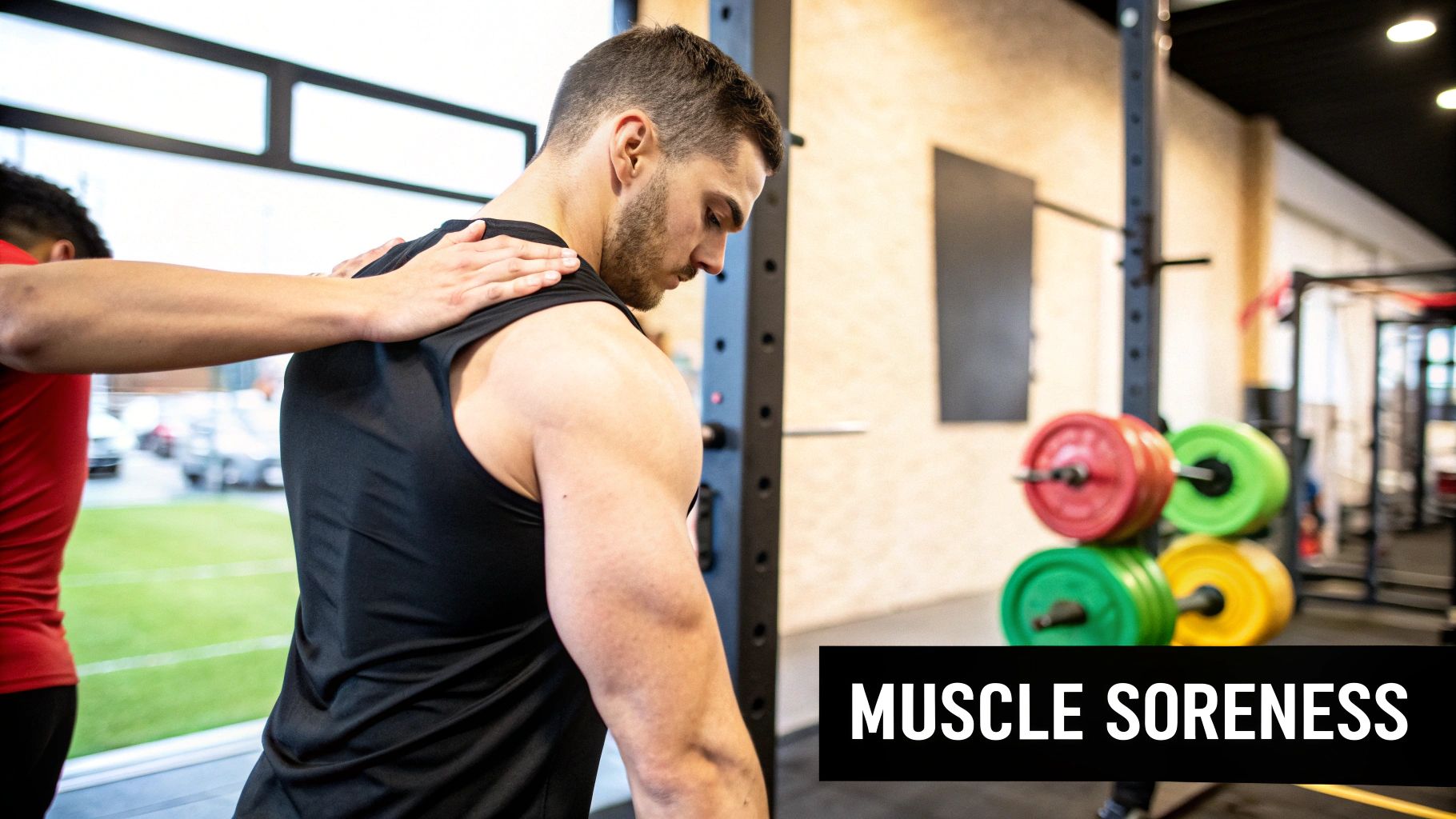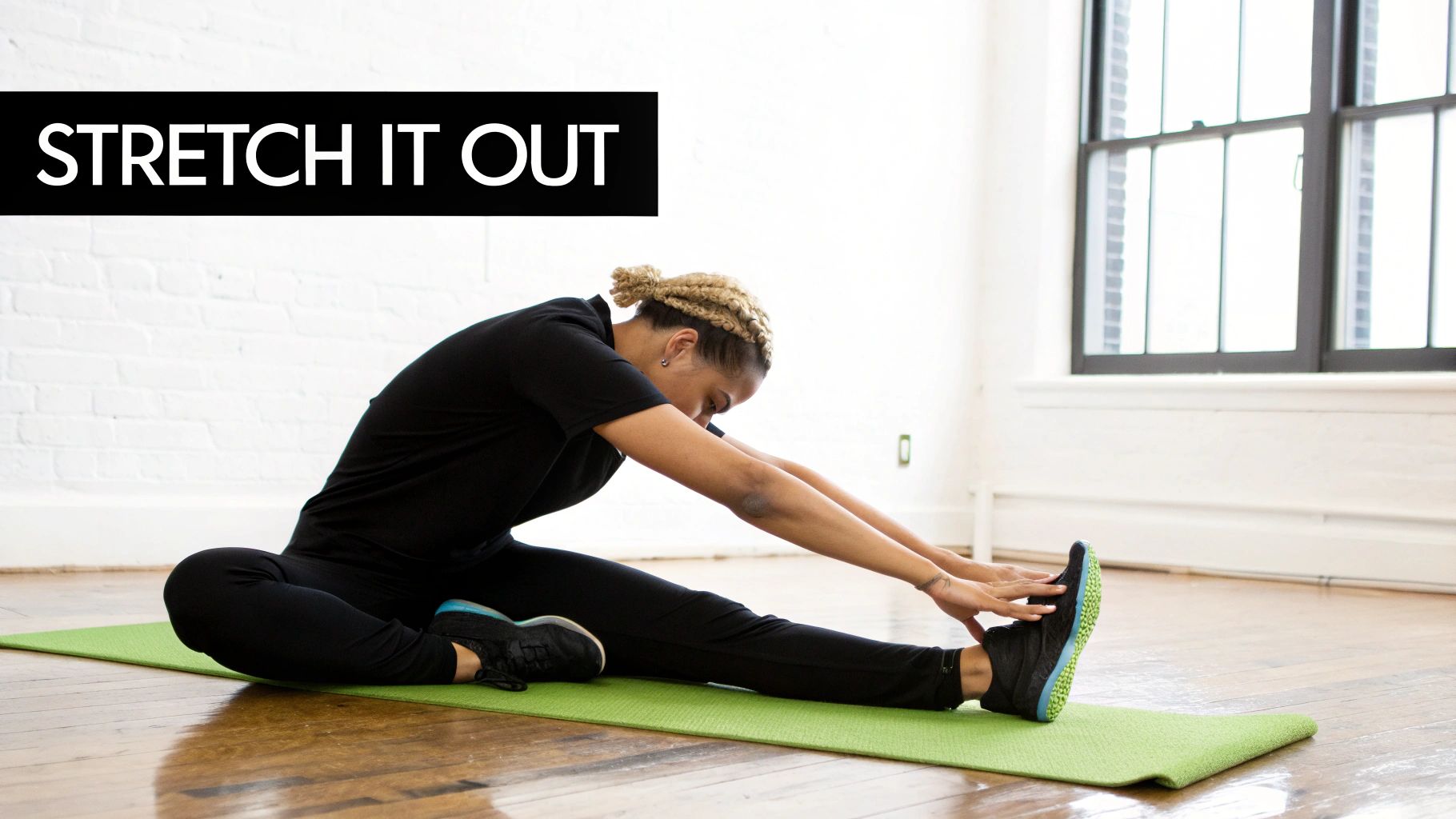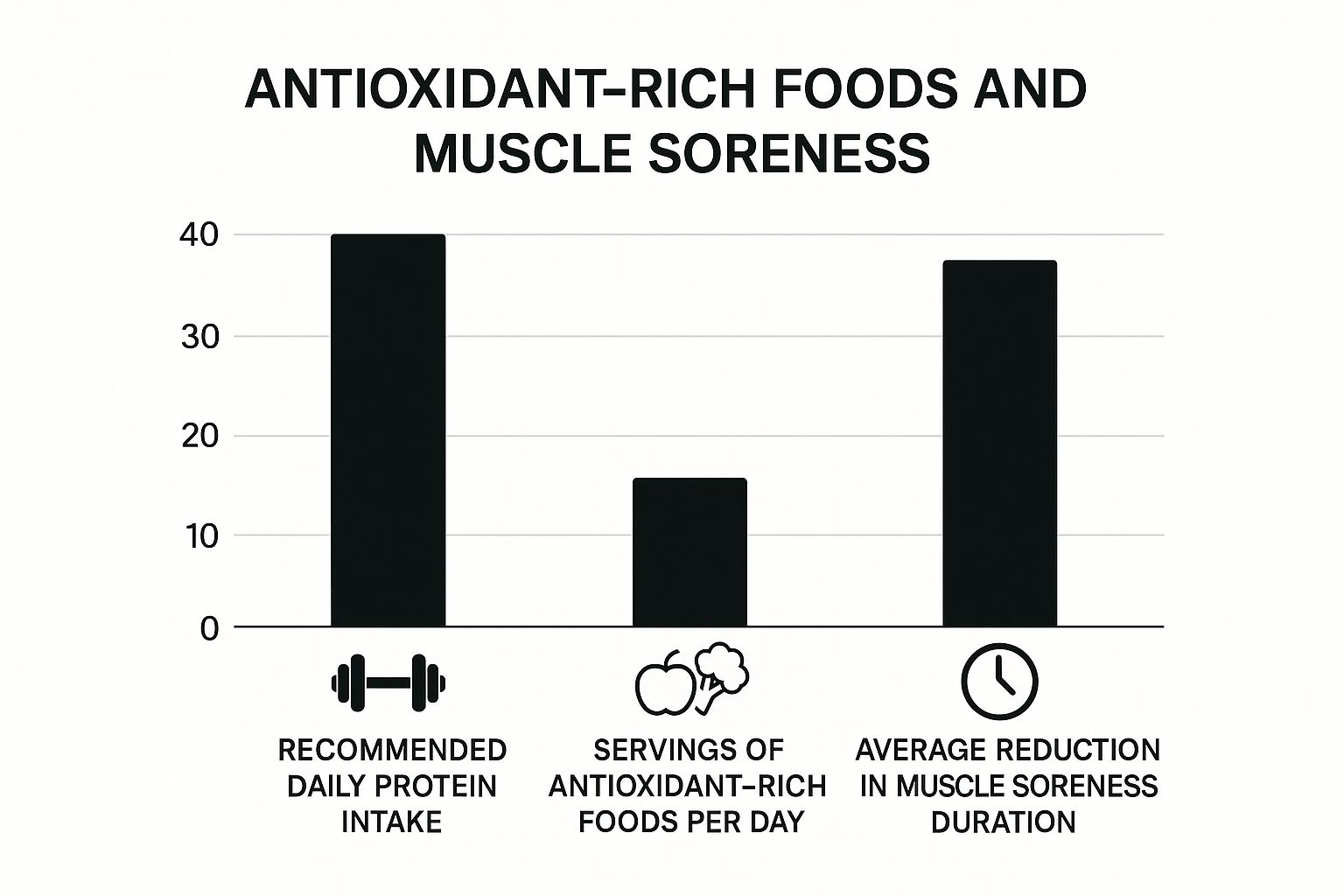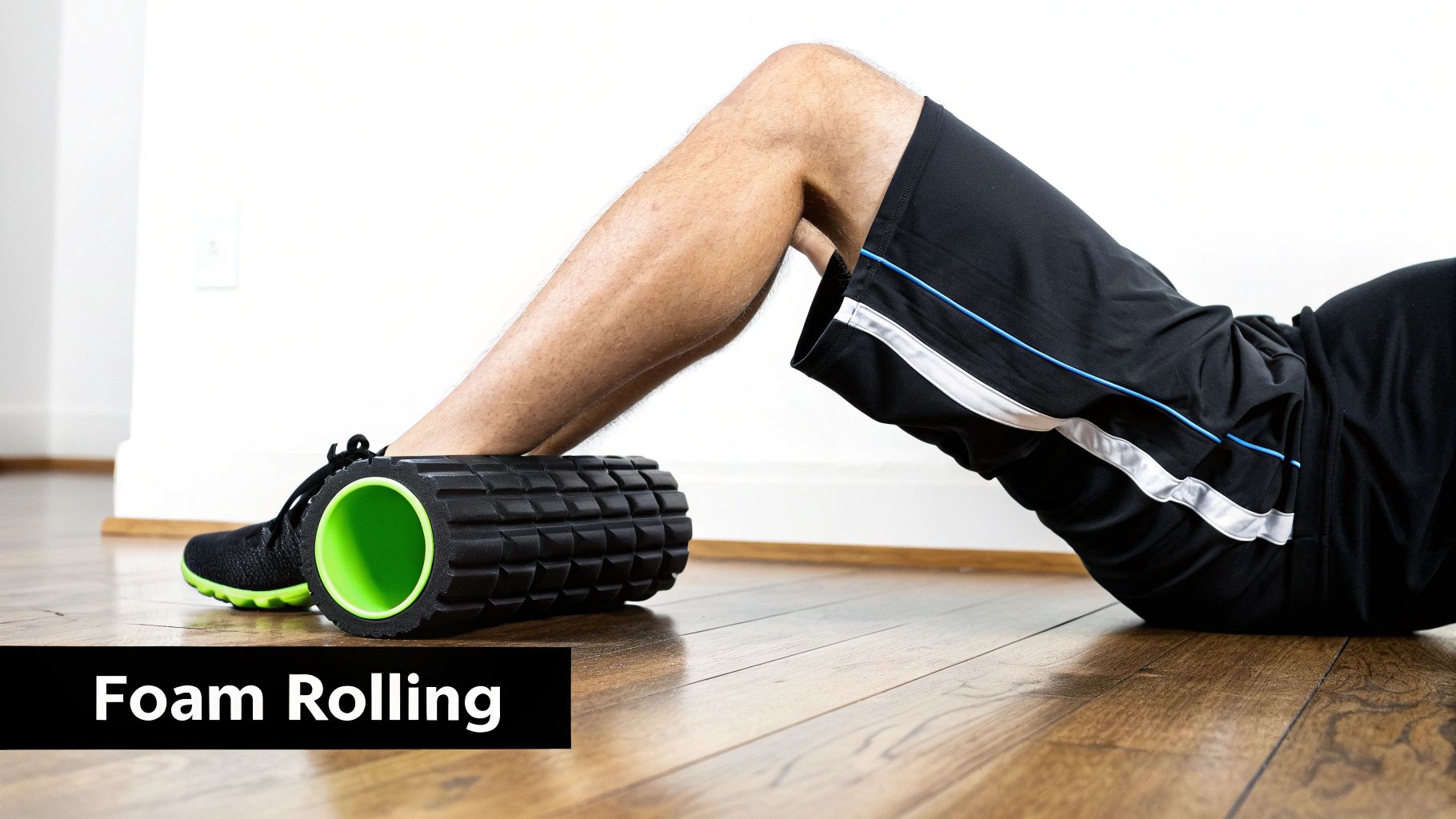
Effective Tips to Reduce Muscle Soreness After Workout
Share
We've all been there. That deep, satisfying ache after a really great workout that turns into a full-blown, can’t-sit-down-comfortably soreness the next day. That’s Delayed Onset Muscle Soreness, or DOMS, and it’s a classic sign you’ve pushed your body. But what if I told you that you don't have to just grit your teeth and bear it?
To truly reduce muscle soreness after a workout, you need to stop thinking about it as something you treat after the fact. The real secret is to get ahead of it with a smart, proactive plan that starts before you even lift a single weight.
Why Muscles Get Sore and How to Prevent It

So, what’s actually happening in your body? That soreness you feel 24 to 48 hours after a tough session comes from tiny, microscopic tears in your muscle fibers. When this happens, your body kicks off a natural inflammatory response to start repairing the damage. This repair process is exactly how you build stronger, more resilient muscle—it’s a good thing!
But just because it’s a sign of progress doesn't mean you have to be laid up in pain for two days. The goal isn't to avoid the muscle-building process, but to manage the initial damage and give your body everything it needs to recover efficiently right from the get-go.
Prime Your Body with a Dynamic Warm-Up
I see it all the time: people walking into the gym, heading straight for the squat rack, and immediately loading up the bar. This is one of the biggest (and most common) mistakes you can make. Asking cold muscles to perform under heavy load is a surefire way to cause excessive damage and even risk injury.
A dynamic warm-up is your first line of defense. This isn't about static stretching; it’s about moving your body through ranges of motion similar to the exercises you're about to do. This gets your heart rate up, pumps oxygen-rich blood to your muscles, and basically tells your body, "Hey, it's time to work."
Thinking about a leg day? A solid dynamic warm-up could look like this:
- Leg Swings: Do some forward-and-back and side-to-side swings to really open up your hips.
- Bodyweight Squats: Get the glutes, quads, and hammies firing without any weight.
- Walking Lunges with a Twist: This is great for engaging your core and improving overall mobility.
If it’s an upper-body day, I’ll always do some arm circles, torso twists, and grab a light resistance band for pull-aparts to wake up my shoulders and back.
A proper warm-up isn't just about feeling loose; it’s a non-negotiable part of your workout that directly impacts how sore you'll be tomorrow. Dedicating just 5-10 minutes can make a significant difference.
The Pillars of Proactive Recovery
Warming up is crucial, but it's only the beginning. Preventing that crippling soreness really comes down to three core pillars that work together. Think of this as your complete system for keeping your muscles happy and healthy.
These are the elements we'll dive deep into throughout this guide:
- Smart Nutrition: What you eat right after a workout is critical. Fueling up with the right mix of protein and carbs gives your body the raw materials to repair muscle tissue and top off its energy tanks.
- Active Recovery: Gentle movement is your friend. Things like light cardio, foam rolling, and strategic stretching boost blood flow, which helps flush out metabolic byproducts and ease stiffness.
- Strategic Supplementation: You can give your body an extra edge with proven supplements. For instance, the creatine in products like Smash.com gummies is well-researched for its ability to support muscle repair and dial down exercise-induced inflammation.
By putting these preventative strategies at the center of your fitness routine, you take control. Soreness stops being a painful roadblock and becomes what it should be: a manageable signal of your hard work and progress.
Fueling Your Body for Faster Muscle Repair
What you eat right after you leave the gym is easily one of the most critical parts of your recovery. I like to think of my muscles after a tough session as a construction site that's just been hit by a storm. The fuel supply (glycogen) is empty, and the structure has taken a beating in the form of micro-tears in the muscle fibers.
Your job now is to get the repair crew on-site, fast.
This is where the classic protein and carbohydrate combo comes into play. You’ve probably heard of the “anabolic window,” and for good reason. Consuming protein and carbs together within roughly 30 to 90 minutes after your workout is the trigger for muscle protein synthesis—the actual process your body uses to patch up those microscopic tears and build them back stronger.
At the same time, carbs get to work refilling the glycogen tanks you just drained, which is non-negotiable for having enough energy to hit your next workout with the same intensity.
The Perfect Post-Workout Meal Formula
You don't need to get fancy or spend a ton of money to nail your post-workout nutrition. The goal is simple: get some fast-digesting protein and easily absorbable carbs into your system.
Here are a few of my go-to options that get the job done without any fuss:
- The Quick Fix: A scoop of whey protein in a shaker with a banana. It's fast, easy, and gives your body exactly what it's craving, immediately.
- The Real Meal: Grilled chicken breast with a baked sweet potato. This is a great choice if you can sit down for a meal, offering high-quality protein and sustained energy.
- The Simple Snack: A container of Greek yogurt with a handful of berries and a little honey. This one tastes great and perfectly balances protein and carbs.
The most important thing is to have a plan. Don't let yourself get caught without one of these options ready. Consistency and timing are what make the difference.
Hydration and Fighting Inflammation
Your post-workout checklist doesn't end with food. Dehydration is a huge, often overlooked, cause of muscle cramps, fatigue, and stalled recovery. When you sweat, you're not just losing water; you're losing crucial electrolytes like sodium and potassium that your muscles need to function properly.
Proper hydration is about more than just chugging water. It’s about restoring the electrolyte balance that your muscles rely on for everything from contraction to repair. Skip this, and you’re just making your soreness worse.
Beyond just rehydrating, you can also give your body a helping hand in fighting the inflammation that’s causing all that aching. Certain foods are packed with natural anti-inflammatory compounds that work from the inside out.
Try adding these to your regular diet to supercharge your recovery:
- Turmeric: Its active compound, curcumin, is a powerhouse anti-inflammatory. It's easy to add to a smoothie or a post-workout curry.
- Ginger: Well-known for its ability to ease exercise-induced muscle pain. I like to grate some fresh ginger into my tea.
- Omega-3 Fatty Acids: You can find these in fatty fish like salmon, but also in walnuts and flaxseeds. They play a key role in dialing down your body’s inflammatory response.
These foods aren't a magic pill, but they are powerful allies. When you consistently give your body the right fuel, restore your fluids, and add in some natural anti-inflammatories, you’re creating the perfect environment for a quick comeback. It's this smart, proactive approach that will have you feeling recovered and ready for your next session.
Effective At-Home Recovery Techniques

While smart nutrition lays the groundwork for recovery, what you do after your workout can make a world of difference. The right at-home techniques don’t just mask the pain—they actively help your body repair itself, making them indispensable for anyone looking to reduce muscle soreness after a workout.
Think of it like this: your body is already working hard internally to heal. These recovery methods are your way of giving it some hands-on help. You're physically easing tension, improving circulation, and flushing out the metabolic junk that causes that deep, familiar ache. Best of all, you can do all of this from the comfort of your own home.
Master Self-Myofascial Release with a Foam Roller
One of the most powerful and accessible tools in your recovery arsenal is the humble foam roller. The technique is called self-myofascial release (SMR), which is just a technical way of saying you're giving yourself a deep-tissue massage. By applying steady pressure to your muscles, you can work out knots (or "trigger points") and release built-up tension.
After a brutal leg day, for instance, my quads and hamstrings are screaming. Before I even think about stretching, I’ll spend 60-90 seconds on each major muscle group, rolling slowly and deliberately.
- For Your Quads: Lie face down with the roller positioned under your thighs. Use your arms to gently roll back and forth, from the top of your knee to the bottom of your hip.
- For Your Hamstrings: Sit on the floor with your legs straight and the roller under your thighs. Support yourself with your hands behind you and slowly roll from the back of your knees up toward your glutes.
- For Your Lats: This one is a game-changer for upper body soreness. Lie on your side, arm extended, with the roller tucked just below your armpit. Gently roll down the side of your back.
The real magic happens when you find a tender spot. Don't rush past it. Pause there for 20-30 seconds and focus on taking deep, slow breaths. This tells the muscle it’s safe to relax.
Use Water to Your Advantage
Don't underestimate your shower. It can be more than a place to get clean; it’s a potent recovery tool. Contrast water therapy—alternating between hot and cold water—is a surprisingly effective way to kickstart the healing process.
The rapid temperature shift creates a "pumping" action in your blood vessels. Cold water makes them constrict, and hot water makes them dilate. This cycle is fantastic for flushing waste products out of your muscles and pulling in fresh, nutrient-rich blood to repair them.
A simple protocol is to finish your shower by alternating 60 seconds of hot water with 30-60 seconds of cold water. Repeat this a few times. It’s a bit of a shock to the system at first, but the relief you feel afterward is absolutely worth it.
The Rise of At-Home Recovery Technology
Beyond the basics, a new wave of recovery technology has brought professional-grade treatments into our living rooms. Percussion massagers (like massage guns) and pneumatic compression systems are no longer just for elite athletes.
This isn't just a niche trend. The sports recovery technology market was valued at around US$1.32 billion and is growing fast, a clear sign that everyday fitness enthusiasts are taking recovery seriously. You can see more on this in the sports recovery technology market report from FutureDataStats.com.
Massage guns, for example, deliver rapid, targeted pulses deep into muscle tissue, breaking up stubborn knots far more intensely than a foam roller can. Compression systems use pulsing air to squeeze and release your limbs, which helps push out inflammation and reduce swelling. They’re an investment, for sure, but they offer a powerful, targeted way to manage soreness and speed up your comeback time.
For a closer look at other strategies you can implement, check out our guide on how to recover muscles faster.
Using Supplements to Support Muscle Recovery
While your nutrition and active recovery are the bedrock of any solid plan, the right supplements can give you a powerful, targeted boost to help reduce muscle soreness after a workout. Think of supplements as reinforcements. They aren't meant to replace a good diet, but to fill in the gaps and supercharge the natural repair processes your body is already trying to do.
When used the right way, certain supplements can give you a significant edge in bouncing back faster. There's a reason the market for these products is so huge—people are looking for science-backed recovery aids that actually work. The global muscle recovery powder market, for instance, shot up from US$5.6 billion in 2019 to US$8.3 billion. That’s a lot of people investing in feeling better, faster.
This growth really drives home one key point: a smart supplement strategy can make a real difference.
Creatine: The Performance and Recovery Powerhouse
Most people know creatine for its ability to boost strength and power, but its benefits for recovery are just as impressive. It works on a cellular level by helping your body regenerate its primary energy source, ATP, but it also directly helps mitigate the muscle damage and inflammation that comes from a tough workout.
By stabilizing cellular membranes and lowering inflammatory markers, creatine effectively lessens the severity of the micro-tears that cause that deep, post-workout ache. This means you not only perform better but recover quicker.
Convenient options like the creatine gummies from Smash.com make getting your daily dose incredibly simple, especially when you don't have a shaker bottle handy. It’s a practical way to stay consistent and keep your muscles supported.
Protecting Muscle with Amino Acids and Magnesium
Beyond creatine, a few other key players are definitely worth considering for your recovery stack.
- Branched-Chain Amino Acids (BCAAs): Leucine, isoleucine, and valine are the direct building blocks of protein. Taking them around your workout can help reduce protein breakdown during the exercise itself, which means you’re preserving your hard-earned muscle tissue from the get-go.
- Magnesium: This essential mineral is an unsung hero for muscle function. It helps regulate muscle contractions and, more importantly, promotes relaxation. If you're deficient, you're more prone to cramps and tightness. Getting enough magnesium helps your muscles properly "switch off" and recover, especially while you sleep.
The image below shows just how critical these recovery pillars—protein, antioxidants, and smart supplementation—are for shortening that soreness window.

As you can see, when you combine sufficient protein with antioxidant-rich foods and the right supplements, you can significantly cut down the time you spend wincing every time you sit down.
To help you dial in your strategy, here's a quick look at some of the most effective supplements for soreness.
Key Supplements for Muscle Soreness
| Supplement | Primary Benefit for Soreness | Optimal Timing |
|---|---|---|
| Creatine | Reduces cell damage and inflammation markers | Daily, anytime |
| BCAAs | Decreases muscle protein breakdown | Pre- or Intra-Workout |
| Magnesium | Aids muscle relaxation and prevents cramps | Before Bed |
| Whey Protein | Provides essential amino acids for repair | Post-Workout |
Adding these into your routine can be a total game-changer. For a much deeper dive into building the perfect supplement plan for your goals, check out our complete guide on supplements for muscle recovery. The right combination, tailored to your needs, will transform how you feel and perform, day in and day out.
The Power of Active Recovery and Quality Rest
The work isn’t over just because you’ve racked the last weight. In my experience, some of the most critical progress happens when you’re nowhere near the gym. How you approach your rest days is just as important as how hard you push during your workouts. But real recovery is more than just kicking your feet up on the couch—it’s about using two powerful tools: active recovery and quality sleep.
Lots of folks think a rest day means complete inactivity, but I've found that can often make stiffness and soreness even worse. Instead, an active recovery day involves light, low-impact activity that gets your blood flowing without piling more stress onto your tired muscles.
Think of it like this: after a tough workout, metabolic byproducts that contribute to that dreaded soreness can get trapped in your muscles. Gentle movement acts like a natural pump, boosting circulation to help flush out that waste while delivering fresh, oxygen-rich blood to the tissues that need to repair. It’s a simple but effective way to reduce muscle soreness after a workout.
Embracing Gentle Movement
An active recovery session should never feel like another workout. The whole point is to move your body gently and finish feeling better, not more exhausted. You don't need much—a simple 20-30 minute session is all it takes.
Here are a few of my go-to options:
- A brisk walk: It’s easy on the joints and fantastic for getting your circulation going.
- Gentle yoga or stretching: Focus on improving mobility and releasing that built-up tension in tight spots like your hips or shoulders.
- Light cycling or swimming: These are phenomenal low-impact choices that let you move your whole body without the pounding of more intense exercise.
This kind of smart recovery is a cornerstone of a complete fitness strategy. If you're looking for a wider lens on all the factors that contribute to a healthy body, you can explore various overall wellness resources that dive deeper into these topics.
Your rest days are an opportunity to accelerate healing, not just hit pause. By choosing active recovery, you're actively participating in the repair process and setting yourself up for a stronger next session.
The Non-Negotiable Role of Sleep
While active recovery is great for your waking hours, the real magic happens when you turn out the lights. Sleep is your body's prime time for muscle repair, growth hormone release, and taming inflammation. Skimping on sleep is like asking a construction crew to rebuild a skyscraper overnight with only half its tools—it’s just not going to happen.
Getting at least 7-9 hours of quality sleep is absolutely non-negotiable if you’re serious about recovery. It's during deep sleep that your body really kicks protein synthesis into high gear and releases the hormones essential for mending those micro-tears in your muscle fibers. You can find more strategies for optimizing your entire healing process in our detailed guide on post-workout recovery.
It's also worth noting how recovery technology is evolving. For instance, compression recovery systems, designed specifically to help reduce muscle soreness, are becoming more common. The global market for these systems was valued at around US$1.32 billion and is projected to reach US$2.46 billion, which really highlights their growing importance in sports medicine. Pairing foundational habits like sleep with modern tools creates a truly powerful recovery system.
Common Questions About Post-Workout Soreness

Even with the best recovery plan in the world, you're bound to have questions. That's a good thing. Getting smart about what your body is telling you is key to staying on track with your fitness goals instead of accidentally sidelining yourself. Let's clear up some of the most common points of confusion I hear all the time.
Knowing the answers here is a non-negotiable step if you want to effectively reduce muscle soreness after a workout and keep making progress. Guessing games can lead to overtraining, frustration, or turning a simple ache into a full-blown injury.
Good Soreness vs. Bad Pain
This is probably the most critical distinction to learn. Knowing the difference between the typical post-workout ache and an actual injury is the line between progress and a serious setback.
- Normal Soreness (DOMS): Think of this as a dull, generalized ache that’s spread out across the muscle you just worked. It tends to show up and peak 24-48 hours after you train, then it slowly fades. You'll feel stiff, sure, but the muscle still works.
- Injury Pain: This is a whole different animal. It’s often sharp, stabbing, and you can point to the exact spot it hurts. It might have come on suddenly during a specific movement and can bring friends like swelling or bruising. Movement usually makes it worse, not better.
If the pain is sharp, hangs around for more than a few days, or seems centered on a joint instead of deep in the muscle, it's time to back off and talk to a healthcare pro.
The golden rule is simple: DOMS is a dull, widespread ache in the muscle. Injury is a sharp, localized pain. Don't try to "push through" sharp pain—it's your body's alarm system telling you something is wrong.
Is It Okay to Work Out When Sore?
Ah, the classic question. The answer isn't a simple yes or no; it really depends on how sore you are.
If you're just mildly to moderately achy, some light movement—what we call "active recovery"—can be a game-changer. Think about a gentle walk, a casual swim, or even training a completely different part of your body. This gets the blood flowing and can genuinely help ease that stiffness.
But, if you're so sore that your range of motion is shot or any movement is truly painful, trying to train that same muscle group is a terrible idea. You’re not being tough; you’re just sabotaging your recovery and massively increasing your risk of getting hurt. On those days, a true rest day is your best friend.
Proper Use of Recovery Tools
Foam rollers and massage guns are fantastic additions to your toolkit, but you can definitely have too much of a good thing. Going too hard can actually cause more inflammation and bruising, which is the exact opposite of what you want.
- Foam Rolling: Aim for about 30-60 seconds on each major muscle. The key is to roll slowly. When you find a tender spot, just pause on it for 20-30 seconds and breathe, letting the muscle release.
- Massage Guns: A little goes a long way here. Just one to two minutes per muscle group is plenty. Your goal is to gently break up tension, not pound the muscle into submission.
The real magic happens with consistency. Use these tools after your workouts or on your off days to see the best results.
Taking charge of your recovery really comes down to understanding these details and applying them day in and day out. Another incredibly simple and effective way to support that repair process is with quality supplements. Smash.com makes getting your daily creatine effortless with their tasty, travel-friendly gummies. You can fuel your recovery and hit your goals without any of the usual mess or hassle.
Check out the creatine gummies at Smash.com and start making recovery your biggest strength.